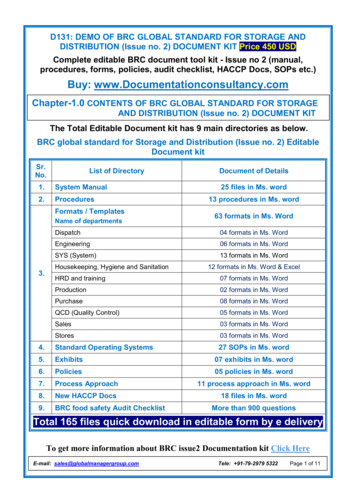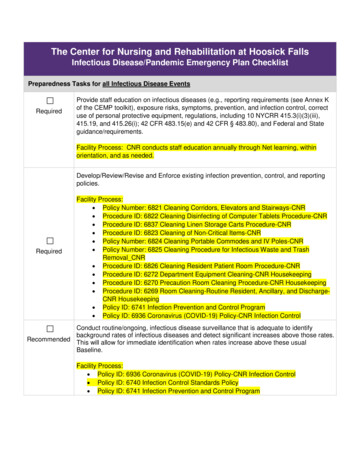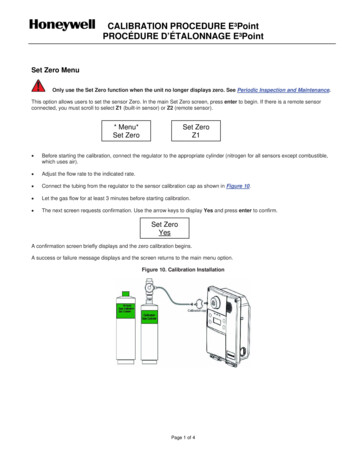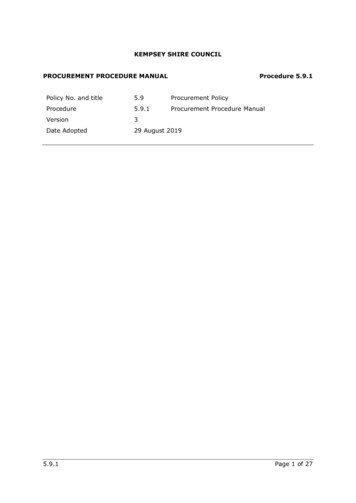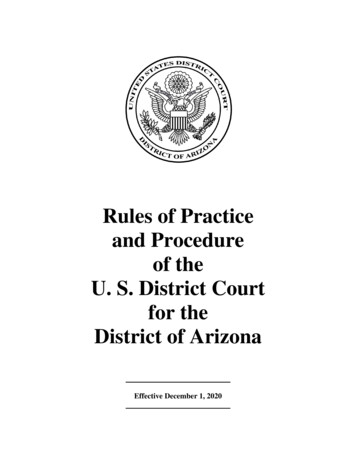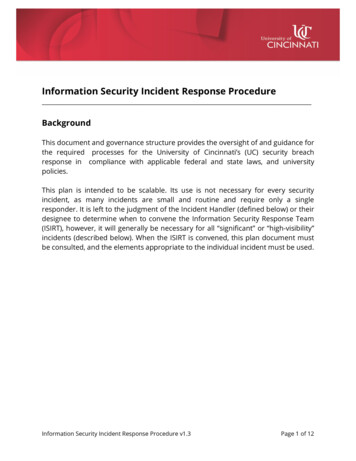
Transcription
Information Security Incident Response ProcedureBackgroundThis document and governance structure provides the oversight of and guidance forthe required processes for the University of Cincinnati’s (UC) security breachresponse in compliance with applicable federal and state laws, and universitypolicies.This plan is intended to be scalable. Its use is not necessary for every securityincident, as many incidents are small and routine and require only a singleresponder. It is left to the judgment of the Incident Handler (defined below) or theirdesignee to determine when to convene the Information Security Response Team(ISIRT), however, it will generally be necessary for all “significant” or “high-visibility”incidents (described below). When the ISIRT is convened, this plan document mustbe consulted, and the elements appropriate to the individual incident must be used.Information Security Incident Response Procedure v1.3Page 1 of 12
TABLE OF CONTENTSSECTION 1: GOVERNANCE .4DEFINITION OF ROLES.4CHARACTERISTICS OF “SIGNIFICANT” OR “HIGH-VISIBILITY” INCIDENTS . 4EMPLOYEE RESPONSIBILITIES .4DEPARTMENT RESPONSIBILITIES.5INFORMATION SECURITY INCIDENT RESPONSE TEAM (ISIRT). 6RESPONSIBILITIES FOR INCIDENT RESPONSE .6SECTION 2: TRIAGE AND SCOPING .7OVERVIEW .7WHAT IS A SECURITY INCIDENT? .7INCIDENT REPORTING.7INITIAL INCIDENT REPORTS .8INITIAL INCIDENT DOCUMENTATION .8INCIDENT CLASSIFICATION . 10CONTAINMENT STRATEGY . 11PRESERVATION OF EVIDENCE . 11INCIDENT DOCUMENTATION . 12IDENTIFY AND ENGAGE RELEVANT EXPERTISE . 12COMMUNICATION/DISCLOSURE STRATEGY . 12SECTION 3: EXECUTION . 13PREPARATION . 13CONTAINMENT . 13ANALYSIS: DATA & SYSTEMS . 13FORENSIC ANALYSIS . 14Information Security Incident Response Procedure v1.3Page 2 of 16
SECTION 4: REMEDIATION AND POST-INCIDENT REVIEW . 14RESPONSIBILITIES . 14TECHNICAL ACTIONS . 15POLICY AND ORGANIZATION . 15RECOMMENDATIONS AND NEXT STEPS . 15DEFINITIONS . 15CONTACT INFORMATION . 16RELATED LINKS . 16HISTORY . 16Information Security Incident Response Procedure v1.3Page 3 of 16
SECTION 1: GOVERNANCEDEFINITION OF ROLES AVP of Information Security – Serves as the governing authority of for all informationsecurity incidents and responsible for communication with IT@UC and universityleadership.Incident Handler - The AVP of Information Security will designate either an individual or afunctional position to be responsible for the oversight of the incident investigation. Thisindividual, or their designee, will determine whether to convene the Information SecurityIncident Response Team (ISIRT) and will communicate the details of the incident toparticipating teams.Incident Analyst(s) – Staff members from the IT@UC Office of Information Security (OIS)responsible for the hand-on incident response and report to the Incident Handler.External Entities – Sometimes, external entities are required to aid in the response for asignificant incident. These entities will be contacted on a per-incident basis, and will beinvolved as deemed appropriate. Examples of external entities are, but not limited to:Internet Service Providers (ISPs), Security Solutions Vendors, consultants and lawenforcement (e.g. FBI and DHS).CHARACTERISTICS OF “SIGNIFICANT” OR “HIGH-VISIBILITY” INCIDENTSThe ISIRT will almost always be convened for all “significant” or “high-visibility” incidents. This is aninherently subjective criterion, so individual judgment is required. However, for the purposes ofguidance, some examples of such incidents include, but are not limited to: Incidents involving key UC personnel, such as campus leadership and prominent faculty oralumni.Incidents for which a press release may or will be issued or media coverage is anticipated.Incidents involving 25 or more affected individuals (incidents involving fewer individualsmay still be “significant” or “high-visibility,” e.g. UC leadership).Incidents likely to result in litigation or regulatory investigation.Incidents involving criminal activity.Any other incident that is likely to involve reputational, regulatory or financial risk to UC ofwhich senior management should be aware.EMPLOYEE RESPONSIBILITIESEvery faculty and staff member at UC has the responsibility to immediately report suspected orInformation Security Incident Response Procedure v1.3Page 4 of 16
known information security incidents or breaches of the privacy or security of Restricted data tothe IT@UC Office of Information Security. Criminal acts, such as theft, or suspected criminal acts,should also be reported to the UC Police Department (UCPD).DEPARTMENT RESPONSIBILITIESAll departments and colleges are responsible to maintain, keep up-to-date, and provide to OIScontact information of Data Custodians, IT administrators, and management to be notified in caseof an information security incident.Information Security Incident Response Procedure v1.3Page 5 of 16
INFORMATION SECURITY INCIDENT RESPONSE TEAM (ISIRT)The following are the minimum required individuals or functional areas for the ISIRT for everyincident for which the ISIRT is convened (smaller incidents will likely be handled by the InformationSecurity staff): Incident HandlerIncident Analyst(s)AVP of Information Security (for “high visibility” and “significant” incidents)The following functions, and any others not listed, may be added to the ISIRT, as appropriate tothe incident: Information technology system owners and appropriate support personnelDirector of PrivacyOffice of General CounselEnterprise Risk ManagementDepartment Leadership of affected unit(s) (Dean, Chair, etc.) or their designeeOffice of the ProvostPublic Information Officer/Public AffairsGovernment Relations/Legislative LiaisonHuman Resources/Academic PersonnelUCPD and other law enforcement, including FBI, as appropriateOffice of Internal AuditOffice of Governmental Relations and CommunicationsExport Controls OfficeOffice of Emergency ManagementOther executives, as appropriateRESPONSIBILITIES FOR INCIDENT RESPONSE Upon initial determination of a possible security incident, departmental management shallnotify OIS immediately.The ISIRT is responsible for the execution of all the Sections of this plan that are applicableto the specific incident, and may deviate from this plan, after consultation with the AVP ofInformation Security, to the extent necessary to respond to the incident.As one of their first actions, the Incident Handler shall consult with legal counsel to identifypossible conflicts of interest in the investigation. In particular, individuals or teams may notlead investigations within their own areas of responsibility. Counsel should also beconsulted regarding possible law enforcement involvement, or the need for forensicinvestigation.Information Security Incident Response Procedure v1.3Page 6 of 16
As one of their first actions, the Incident Handler shall consult with Enterprise RiskManagement to determine whether University of Cincinnati Cyber/Internet Liability &Breach Response Services might provide insurance coverage for the incident, or should beengaged in response.The Incident Handler shall ensure that resources are assigned to conduct the investigation,as applicable to the incident. In the event of possible conflicts of interest, those resourcesmust be sufficiently independent to avoid the appearance of a conflict of interest.For an electronic incident, OIS shall conduct the forensic investigation.The ISIRT is responsible to ensure that, if necessary, evidence is preserved, and eachincident is adequately documented. “Adequate” documentation will stand on its own,without requiring further explanation.SECTION 2: TRIAGE AND SCOPINGOVERVIEWThe triage and scoping phase involves the process of analyzing the information about the situationto determine whether or not a security incident has occurred. This section includes guidance forincident identification, initial reporting, priority-setting based on data and system criticality andsensitivity, required collection and analysis of incident information, information preservation,documentation, and communication.WHAT IS A SECURITY INCIDENT?A security incident may involve, but is not limited to, any or all of the following: A violation of campus policies and standardsUnauthorized system or information accessLoss of information confidentialityLoss of system or information availabilityCompromise of system or information integrityDenial of service condition against data, network or computerMisuse of service, systems or informationPhysical or logical damage to systems, or device theftPresence of an unauthorized application, such as malwareUnauthorized or suspicious network activityINCIDENT REPORTINGAll suspected or confirmed privacy or data security incidents must be reported to OIS in accordancewith the Information Security Incident Management and Response Policy. The initial severity levelInformation Security Incident Response Procedure v1.3Page 7 of 16
may be escalated or de-escalated by the information security staff for an electronic incident. Allincident reports are to be made as soon as possible after the incident is identified, and withminimum delay for medium to high severity incidents.INITIAL INCIDENT REPORTSInitial incident reports must include the following information when describing the incident: Date and time of incident discoveryGeneral description of the incidentSystems or data at possible riskActions they have taken since incident discoveryTheir contact informationAny additional relevant information known at the timeINITIAL INCIDENT DOCUMENTATIONMost incidents will not be directly reported to the Incident Handler, but most likely will beprocessed through local IT support structure or business unit management. If the ISIRT is convenedfor an incident, the information identified in Figure 1, or as much of the information as is available,must be collected, documented and shared with the ISIRT. When possible, the information will beobtained directly by a member of ISIRT, unless incident circumstance prevent this.Information Security Incident Response Procedure v1.3Page 8 of 16
Figure 1Incident Reporting ElementsInformation to RecordDescriptionReferencesAssign the next sequentially available OIS incident or investigation number as appropriateSuggested Severity LevelLow, Medium, High, CriticalType of IncidentNote all types that apply, including but not limited toCompromised SystemCompromised User CredentialsNetwork Attacks (DOS, Scanning, Sniffing)Malware (Viruses, Worms, Trojans)Lost Equipment/TheftPhysical Break-inSocial Engineering (Phishing)Law Enforcement RequestPolicy ViolationGeneral Counsel Request (non-specific)Public Records RequestLitigation Hold/SearchCopyright ViolationData Breach (physical or electronic)Export Controlled Data nt TimelineDate/time that the incident was discoveredDate/time that the incident was reportedDate/time or data range that the incident occurred (if known)Who or what reported theeventPerson or Persons:Contact Information for the Incident Reporter: full name, user ID (6 2), organizational unit/department,title, email address, phone number, and location (mailing address, office room number).Automated System:Name of software package, name of the host where the software is installed, physical location of thehost, system owner or department, network address of the host, and MAC address of the host if possible.Incident ContactInformationList contact information for all parties involved in the incident.Detailed descriptionof the eventInclude as much information as possible such as:Description of the incident (how it was detected, what occurred)Description of the affected resourcesDescription of the affected organizationsEstimated technical impact of the incident (i.e. data deleted, system crashed, application unavailable)Summary of response actions performedOther organizations contactedCause of the incident if known (misconfigured app, unpatched host, etc.)List of evidence gatheredTotal hours spent on incident handling and/or additional non-labor costs involved in handling (estimate)Incident Handler CommentsIdentification of thehost(s)Source of the Incident: List of sources Host name/IP AddressTarget of the Attack: Host Name/IP Address (note: Target of the attack should not be listed for incidentsinvolving protected health information or sensitive student information)Incident HandlingAction LogInclude: actions taken, when, by whomPhysical SecurityControlsIf there is limited physical access to the computer, document the physical security controls that limit access (askthe person reporting the event to describe what they have to do to access the computer).Information Security Incident Response Procedure v1.3Page 9 of 16
INCIDENT CLASSIFICATIONAll incidents that are processed by the ISIRT shall be classified by the ISIRT. Incident classificationinforms those involved of the severity and impact of the incident, and ensures that the incidentreceives the appropriate level of attention. Classification also ensures that the incident is reportedto management in a timely manner.The incident classification table, Figure 2, provides several incident factors to assist in properincident classification. Depending on the nature of the incident, some of the incident criteriarepresented in the table may not be present in a particular incident. Moreover, if an incidentcontains characteristics in several different severity columns, the severity of an incident mustreflect the highest category.Incident classification is a dynamic process. Incident severity may change one or more times asincident details emerge over time during the investigation process.Information Security Incident Response Procedure v1.3Page 10 of 16
Figure 2Incident Classification TableLowInternal systems andapplicationsIncident Severity CharacteristicsMediumHighInternal or externalInternal or externalsystems and applicationssystems and applicationsCriticality – Infrastructure(As defined in the CriticalSystem Inventory)User systemNon-critical enterprise systemCritical enterprise systemCriticality – InfrastructureNoLimited ScopeCampus-wide impactImpact – User/SystemAffects few people or fewsystemsNoneDepartment-wideimpactPotential impactCampus-wide impactSolutions are readilyavailableRobust encryptionalgorithm, and keycontrolAvailable and welldefinedWeak countermeasuresNo countermeasuresWeak algorithm and/or keycontrolsNo encryption, oreasily defeatedencryptionNo resolution proceduresor bypass availableIncident FactorsCriticality – ApplicationImpact – PublicCountermeasuresEncryptionResolution ProceduresInformation SensitivityResearch Intellectual PropertyProtected Information(Personally- IdentifiableInformation or ProtectedHealth Information)Affects an individualresearcher, employee orunitInitial datasetsNoneResolution procedure notwell-defined, bypassavailableAffects an individual collegeor departmentDefinite impactUniversity-wide, statewide ornational impactResearch working papersand completed datasetsPublishable researchPossibleDefiniteCONTAINMENT STRATEGYA containment strategy must be implemented that will limit the damage to university resources.The containment strategy must include contact information for various campus organizations andpersonnel who may be involved in incident response. Containment may involve a combination oftechnical controls, such as network and system disconnects, as well as media and communicationsto the public and to staff, depending upon the scope of the breach.PRESERVATION OF EVIDENCEInformation Security Incident Response Procedure v1.3Page 11 of 16
Consideration should be given to preserving evidence during the Triage and Scoping Phase,particularly if it becomes apparent that the incident involves criminal activity. Containment,however, takes precedence over preservation while the incident is active. Proper preservation ofevidence requires establishment of chain of custody procedures prior to an incident. Any electronicevidence should be properly tracked in a documented and repeatable process.INCIDENT DOCUMENTATIONThe importance of adequate and sufficiently-detailed documentation cannot be over-emphasized,especially if regulatory investigation(s) or lawsuit(s) arise as a result of the incident. Very seriousconsideration must be given to dedicating a single, full-time resource to adequately document thedecisions that are made, and the actions taken, particularly for larger incidents. It is especiallyimportant to begin this type of documentation as soon as the need for the ISIRT is identified, sothat documentation is performed dynamically during the incident.IDENTIFY AND ENGAGE RELEVANT EXPERTISEIdentifying and engaging groups and individuals with relevant expertise is critical to accuratelytriage an incident and determine its scope. In large or complex cases, the ISIRT should considerbringing in a third party, such as an external organization to assist in the triage and scoping effort.In order to comply with terms of liability insurance, the insurance carrier may conduct a forensicinvestigation and participate in the incident response activities. Cooperation with the insurancecarrier is required under the terms and conditions of the insurance policy.In incidents where the level of severity or data impacted warrants, the ISIRT should considerengaging individuals and groups with appropriate subject matter expertise as described in theInformation Security Incident Escalation Guideline. Incident Handler, or their designee, willestablish contact with designated departments and/or individuals after an initial assessment andclassification of the incident has been performed by the ISIRT.COMMUNICATION/DISCLOSURE STRATEGYProper handling of internal and external communications is critical in the initial phases of incidentresponse. It is quite possible that an initially small incident could grow into a large multi-siteincident. It is also quite possible that a suspected incident could be determined to be unfounded.Improper handling of communications could lead to embarrassment to the university in the eventof a false positive, or could tip off any malicious attackers to cover their tracks, thus exposing theuniversity to more risk.Communication of incidents should be handled on a need-to-know basis, especially early on. TheISIRT will engage the IT@UC Public Information Office and Office of Governmental Relations andInformation Security Incident Response Procedure v1.3Page 12 of 16
Communications to facilitate incident appropriate communication strategies. All communicationsabout the incident external to the ISIRT should be properly documented by the responsibledepartment and conducted through a central point.Legal counsel should be consulted to determine whether the investigation will proceed under thedirection of counsel and attorney-client privilege. If so, counsel will establish particular proceduresfor communication and documentation.If there is an impermissible use or disclosure of Protected Health Information (PHI) belonging to aUC HIPAA covered unit, a breach assessment will be conducted.If it is determined that a breach has occurred, notification will be made to the individuals, Healthand Human Services, and if applicable, the media, in accordance with UC HIPAA policy.SECTION 3: EXECUTIONPREPARATIONThe ISIRT should collect and review the incident documentation and event reports. Thisinformation should first be verified as being factual (information may have been misreported orincorrectly documented). The ISIRT should assign the incident severity, or re-consider itsappropriateness if already assigned. The ISIRT should determine who outside of the ISIRT needs tobe notified of the incident as per the Information Security Incident Escalation Guideline and makethose notifications. Information should be restricted on a need-to-know basis.If the incident requires computer forensic analysis, arrangements must be made to gain access tothe data and devices involved in the incident. The primary objective is to maintain and restorebusiness continuity.CONTAINMENTThe ISIRT must communicate with system owners and departments for incident containment.Individual departments are responsible to engage sufficient staff with appropriate technical skillsto do an effective job of containment.The ISIRT must assess whether to disrupt services to internal or external customers. Decisions ofthis nature must be made in consultation with the appropriate senior leadership and an evaluationof whether the systems impact critical services.ANALYSIS: DATA & SYSTEMSAssess the cause and type of breach. Depending on the documentation provided to the ISIRT, itInformation Security Incident Response Procedure v1.3Page 13 of 16
should either validate or determine what types of data are involved, based on the university DataProtection Policy. The cause of the breach is determined by technical analysis and investigation, asdescribed below.FORENSIC ANALYSISForensic analysis entails a technical examination of evidence, preservation of that evidence,preservation of the chain-of-custody of the evidence, documentation of observations, and analysisdrawn from logical conclusions based on the evidence, absent opinion or conjecture. Whenconducting a forensic analysis, the analyst must adhere to the following principles: Analysis must be an unbiased examination of the evidence submitted.Chain of custody and evidence integrity is maintained thought the whole process ofinvestigation.Forensic analysis does not pronounce or imply guilt. The purpose is to determine whetherindicators exist that can tie the suspect hardware or identity to the incident underinvestigation.Report only verifiable information.Be precise. Statements such as “numerous,” “many,” “multiple hundreds,” etc. should beavoided. Specifically state the finding, as well as the precise locations of information.Identify the evidence being analyzed as thoroughly as possible.SECTION 4: REMEDIATION AND POST-INCIDENT REVIEWRESPONSIBILITIESThe ISIRT communicates the need for remediation to system owners and responsible departments.Teams responsible for remediation will communicate status and results to ISIRT at scheduledintervals.Based findings or an assessment of incident size and complexity, the ISIRT may convenes one ormore Post-Incident Review Teams (PIRTs). PIRTs will typically be converged only for large incidents,although exceptions may be made for complex or sensitive incidents. The ISIRT and PIRTs document and review findings from incident investigation, containmentand resolution activities.ISIRT and PIRTs analyze conditions in the IT environment local to the incident, includingtechnical, policy, and organizational aspects. Scope of review includes circumstances andactivities before the incident as well as during the response.The ISIRT and PIRTs prepare an action plan for recommended changes to improve theuniversity environment going forward.Information Security Incident Response Procedure v1.3Page 14 of 16
PIRTs document lessons learned, including aspects that were good as well as those whichwere problematic.TECHNICAL ACTIONSSpecific technical review activities should include: Review whether remediation of affected local system(s) is complete.o Vulnerable hardware or software has been hardened against any break-ins, futureattacks, or other security issues (e.g. installed patches, updated versions, replacedvulnerable sections of code).Conduct a root-cause analysis.Assess whether security vulnerabilities can be adequately remediated by making changeswithin the current environment or a new/replacement environment should be created.Take needed actions to restore essential systems to functioning status, either in the originalor a repaired environment, or determine that the activities must cease or be suspendeduntil a different or rebuilt environment can be created.Identify any areas where different technical measures would have prevented the breach orimproved results in this environment. Also identify what technical measures worked well.Share lessons learned with appropriate contacts.POLICY AND ORGANIZATIONAnalyze sufficiency of policies and procedures, efficacy of organizational structure, andaccountability of those who were involved, or should have been involved, in risk mitigation and inthe response. Include internal and external environments and individuals who are staff,management and organizational leaders.RECOMMENDATIONS AND NEXT STEPSThe ISIRT assesses findings and recommendations of the PIRT(s), and then issues a report of theincident and its response to the AVP of Information Security, including findings andrecommendations.DEFINITIONSDenial of Service (DoS) - is an attempt to make a machine or network resource unavailable to itsintended users, such as to temporarily or indefinitely interrupt or suspend services of a hostconnected to the Internet. A distributed denial-of-service (DDoS) is where the attack source is morethan one–and often thousands of-unique IP addresses.Information Security Incident Response Procedure v1.3Page 15 of 16
Enterprise system - the overall combination of computer hardware and software that the universityuses to organize and run its operations. Enterprise systems provide core services used across theinstitution and on which other applications or business processes often are dependent.ISIRT – Information Security Incident Response Team. Team responsible for assessment andinvestigation of a security incident involving university technology or data assets.Malware - software that is intended to damage or disable computers and computer systems.Phishing - is a form of fraud in which the attacker tries to learn information such as login credentialsor account information by masquerading as a reputable entity or person in email, or othercommunication channels.Social Engineering - is a non-technical method of intrusion hackers use that relies heavily on humaninteraction and often involves tricking people into breaking normal security procedures.User system – combination of hardware or software that is used by single or multiple individualsto perform their daily duties.CONTACT INFORMATIONIT@UC Office of Information Security513-558-ISEC (4732)infosec@uc.eduRELATED LINKSData Governance & ClassificationInformation Security Incident Management and Response PolicyInformation Security Incident Response Escalation GuidelineHISTORYIssued: 01/23/2019Information Security Incident Response Procedure v1.3Page 16 of 16
POLICY AND ORGANIZATION . Information Security Incident Response Procedure v1.3 Page 5 of 16 . known information security incidents or breaches of the privacy or security oRestricted f data to . processed through local IT support structure or business unit management. If the ISIRT is convened for an incident, the information identified in .
